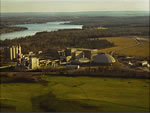The Lafarge Brookfield plant in Nova Scotia has been deemed a “viable disposal solution” for getting rid of treated hydraulic fracturing wastewater being held in storage ponds at Atlantic Industrial Services (AIS) in Debert, reported the Truro Daily News.
The pilot project, approved last April by the Nova Scotia Department of Environment, permitted the transport of 2 million liters of treated wastewater from the AIS holding ponds for use as a coolant in the kiln at the cement plant, where it was evaporated at 700 C.
“When I met with the community last April, I said that we would update people on the results of the pilot and making the results available online is a good way to keep everyone informed,” Environment Minister Randy Delorey said in a news release. “I’m pleased with the findings from the pilot. The results confirm that evaporation provides Nova Scotians with a viable disposal solution.”
Before being evaporated in the kiln, the wastewater had been treated for naturally occurring radioactive materials (NORMS) and put through reverse osmosis. The water was analyzed and met the Canadian Council of Environment Ministers and Health Canada guidelines for release into a freshwater source. As part of the project, Lafarge conducted water testing before, during and after evaporation.
The tests showed comparable results for cooling water normally used by the plant from Shortts Lake, near Truro, and the wastewater from the holding ponds at AIS.
The Department of Environment has received a request for authorization from AIS to remove and treat another 5 million liters at the Brookfield plant. A decision will be announced soon. If approved, any terms and conditions would be the same as the pilot project, requiring dual treatment of the wastewater before evaporation. There are 10 million liters remaining in two ponds at the company’s Debert site.
Triangle Petroleum also has 20 million liters of wastewater in two holdings ponds in Kennetcook, Nova Scotia. The wastewater in both areas is from high-pressure hydraulic fracturing that took place in 2007 and 2008.
The results from the pilot project are available here.

